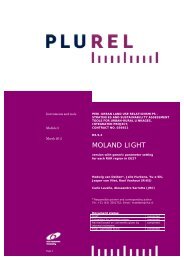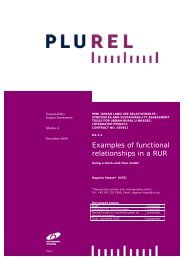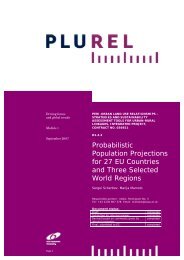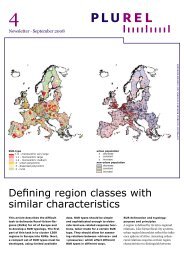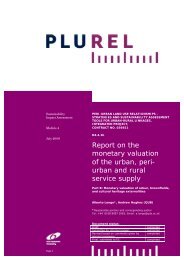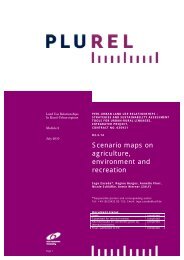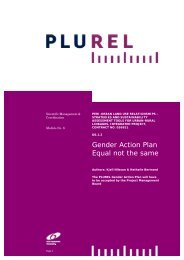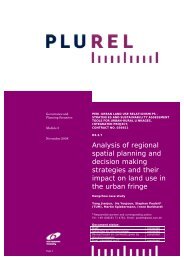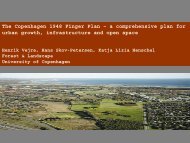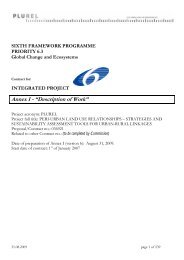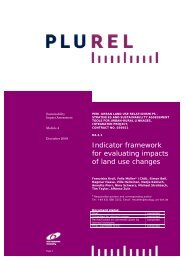Cost benefit analysis of peri-urban land use policy - Plurel
Cost benefit analysis of peri-urban land use policy - Plurel
Cost benefit analysis of peri-urban land use policy - Plurel
You also want an ePaper? Increase the reach of your titles
YUMPU automatically turns print PDFs into web optimized ePapers that Google loves.
Table 8: Specifications <strong>of</strong> each zone<br />
Zone Land cover Functions Benefits<br />
Biodiversity<br />
zone<br />
Hydrological<br />
management<br />
zone<br />
Agricultural<br />
zone<br />
Public<br />
Enjoyment<br />
and Access<br />
zone<br />
Transiting from raised bog to<br />
lagged fen/wet wood<strong>land</strong> and<br />
reed beds<br />
Extensive grass<strong>land</strong>, rushpasture<br />
and mire habitats<br />
Arable cropping,<br />
salad/vegetable growing,<br />
biomass production<br />
Green spaces. For<br />
example, a linear<br />
access/leisure zone could be<br />
created along the Glaze<br />
Brook and the brook could be<br />
remodelled to create a more<br />
natural and responsive<br />
environment with seasonal<br />
water meadows, reedbeds<br />
and willow planting to<br />
increase its biodiversity and<br />
amenity value.<br />
Nature reserve,<br />
heritage and cultural<br />
legacy functions (peat<br />
extraction sites)<br />
Environmentally<br />
sensitive agriculture,<br />
nature conservations,<br />
passive recreation,<br />
hydrological services<br />
(water retention)<br />
Agriculture activities<br />
Reduce pressure <strong>of</strong><br />
<strong>urban</strong> fringe, health<br />
care, bridge to the<br />
country, heritage and<br />
cultural legacy and<br />
nature reserve<br />
functions (e.g. a forest<br />
park)<br />
Educational,<br />
passive<br />
recreational,<br />
nature<br />
conservation,<br />
biodiversity,<br />
climate regulation<br />
(carbon<br />
sequestration)<br />
nitrogen sink<br />
(nitrogen<br />
abatement), but no<br />
exclusive<br />
Agriculture<br />
(diversifying<br />
effects),<br />
conservation,<br />
passive recreation,<br />
<strong>land</strong>scape,<br />
biodiversity (but<br />
not exclusive)<br />
Educational,<br />
leisure, tourism,<br />
agricultural<br />
<strong>benefit</strong>, <strong>land</strong>scape,<br />
environmental<br />
<strong>benefit</strong>s (biomass),<br />
but not exclusive<br />
Recreational<br />
(tourism), amenity<br />
value, conservation<br />
(opportunity: the<br />
Wigan Greenheart<br />
Regional Park)<br />
Several methods are available to estimate the economic values <strong>of</strong> each <strong>of</strong> the <strong>benefit</strong>s listed in<br />
the table, such as revealed preference methods, stated preference methods and <strong>benefit</strong><br />
transfer methods. Whilst revealed preference methods and stated preferences methods are<br />
usually applied in primary studies, <strong>benefit</strong> transfer methods are widely adopted as an<br />
economical alternative when research resources are limited as these methods allow one to<br />
obtain, say, the value <strong>of</strong> biodiversity <strong>of</strong> site A from already estimated biodiversity values <strong>of</strong><br />
other sites.<br />
Page 31 • PLUREL report No 4.4.3 • December 2010



